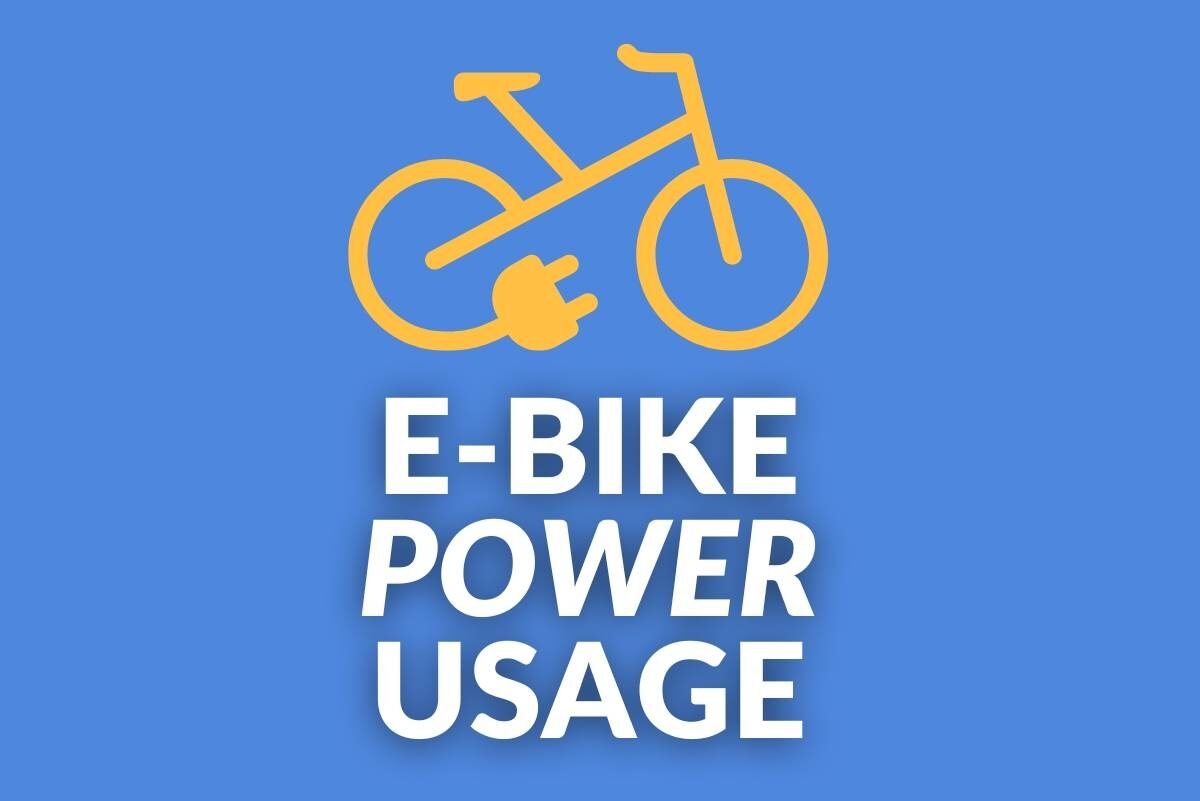
Electric bikes are an excellent and practical mode of transportation, but you may have some questions about their power consumption and charging requirements. To determine how much power your e-bike uses, you need to consider a few factors. Additionally, it’s important to think about the battery’s replacement cost since it’s a significant expense.
As an e-bike rider, you’re probably familiar with the idea of power. It’s a measure of how much work you can do, and having more of it means you can accelerate quickly or climb hills faster without losing speed. In cars and bikes, we use horsepower to measure power, so it’s easy to understand the difference between vehicles with different horsepower.
A kilowatt is a different unit of power typically used with the metric system and is used in the US to measure the power of electric motors. A kilowatt is equal to around 1.34 horsepower. It is equally accurate to state that a compact motorcycle with 10 horsepower has around 7 kilowatts.
However, when it comes to electric bikes, a kilowatt, which is 1,000 watts, is often a large unit. That’s why e-bikes are typically rated in unprefixed watts, with power output ranging from around 250 to 900 watts. To give you a sense of how that translates to horsepower, it’s roughly 1.2 hp or one-third of a horsepower. Just like other vehicles, an e-bike with higher power can travel faster and carry more weight uphill at higher speeds.
This post was written in collaboration with electric bike specialists, Addmotor.

Electric Bike Power Use
To understand what power means in practical terms, we can compare it to the energy expended by a typical rider on a regular bicycle. For example, it takes around 30 watts to pedal at a non-sporting rider’s typical cruising pace of 9 mph, which is roughly equivalent to walking normally. However, when pedaling at speeds of up to 20 mph, it takes about 220 watts, which is more than most non-athletes can sustain due to the rapidly increasing aerodynamic loads.
E-Bike Wattage
The power output of an e-bike’s onboard motor is measured in watts. To determine the rating, you multiply the maximum current (in amps) flowing from the battery to the motor by the battery’s voltage. For instance, an e-bike motor with a 540W output would be powered by a 36V battery and a 15A controller.
Electric bike batteries typically have a capacity ranging from 250Wh to 500Wh, although 750Wh batteries are becoming more common as battery technology improves (especially for heavier models, such as electric fat bikes). In some cases, electric motorcycles even feature two battery connectors to extend their range.

Does Higher Wattage Mean a Better eBike?
Watts and electric bike motors are a touchy subject. Higher wattage e-bike motors will provide quicker acceleration, more power while climbing hills, and overall better performance for larger riders.
However, electric bikes typically aren’t as efficient as your typical runabout. This is because a higher wattage motor will drain the battery faster, resulting in reduced range for the rider. Therefore, it’s essential to consider the wattage of an e-bike when choosing one.
250W vs 500W vs 750W vs 1000W E-Bike
| 250w | 500w | 750w | 1000w | |
|---|---|---|---|---|
| Top Speed | 15-20mph | 20-25 mph | 25-30mph | 30+mph |
| Acceleration | OK | Fast | Faster | Rapid |
| Hill Performance | Acceptable | Decent | Fast | Effortless |
| Cost To Charge | Cheapest | Cheap | Average | Expensive |
E-Bike Voltage
An e-bike’s voltage is the voltage of the battery attached to the bike. Voltage measures the electrical potential of the battery.
To put it simply, the voltage of an e-bike’s battery determines its potential power. A higher voltage means the bike can potentially travel faster, but it’s important to note that e-bikes are typically only permitted to provide assistance up to a certain speed, which varies by country.
Electric bicycles generally use batteries with either 48 or 52 volts. The main difference between the two is in power and performance, with the 52V battery providing better performance. An efficient battery will use less energy to produce the same or better power for the motorcycle compared to a lower voltage battery. Additionally, a 52V battery typically has a longer lifespan. The once popular option of a 36V battery has lost popularity due to its inferior performance compared to the 48V or 52V options.
The table below displays the battery voltage charts for the three distinct e-bike batteries at different charge levels, from 100% charge down to 10% charge.
| Battery % | 36v | 48v | 52v |
|---|---|---|---|
| 100 | 42.0 | 54.6 | 58.8 |
| 90 | 40.8 | 53.0 | 57.1 |
| 80 | 39.6 | 51.5 | 55.4 |
| 70 | 38.4 | 49.9 | 53.8 |
| 60 | 37.2 | 48.4 | 52.1 |
| 50 | 36.0 | 46.8 | 50.4 |
| 40 | 34.8 | 45.2 | 48.7 |
| 30 | 33.6 | 43.7 | 47.0 |
| 20 | 32.4 | 42.1 | 45.4 |
| 10 | 31.2 | 40.6 | 43.7 |
How Much Power Does an Electric Bike Need?
In general, higher wattage means more power for your e-bike. However, some e-bikes have labels that don’t accurately reflect their power level, for marketing or regulatory reasons. To calculate an e-bike’s actual wattage, you’ll need to multiply the battery’s voltage by the controller’s peak current limit (in amps), which may require contacting the manufacturer for information.
Determining the necessary power for your e-bike depends on your weight and the terrain you plan to ride on. Heavier riders will need more power to accelerate, and steeper and longer hills require more power than shorter ones.
As a rider’s weight exceeds 220 lbs (100 kg), the power requirements for an e-bike increase significantly. In flat areas, a 750-watt ebike should suffice, but acceleration may be slower. For hilly terrain, a minimum of 1,000 watts is recommended. Heavy riders tackling steep hills may need to go beyond a 20A controller and opt for a 25A or 30A controller paired with a 48V battery, which can provide 1250-1500 watts of power. However, if the power exceeds 1,000W, overheating may become an issue, particularly during prolonged uphill rides.
How Much Electricity Does an E-Bike Use?
To understand the power consumption of e-bikes, it’s helpful to compare it with other forms of transportation. By most standards, e-bikes consume very little power. The unit of measurement used to quantify the energy required for movement, including electrical energy, is watts. Watts can be used to compare power consumption for various activities such as walking or flying. Watt-hours are a more practical unit of measurement than watts as they represent the amount of power used by an e-bike or any other device in one hour.
Compared to other modes of transportation, e-bikes use significantly less energy. In fact, an e-bike uses only a fraction of the energy required by a plane or an electric car. When comparing energy consumption, it’s important to note that while other modes of transportation may not require electricity, they still consume energy, which can be converted to kWh equivalent to various fuels. In terms of electrical energy, an e-bike requires about one-quarter of the energy used by an electric car and only around one-fiftieth of the energy required by a plane to move.
Although these are rough estimates based on assumptions and averages, the fact remains that e-bikes consume significantly less electrical energy than alternative modes of transportation.

Electric Bike Power (Electricity) Consumption
In today’s market, businesses strive to create unique electric bike designs that stand out from the crowd. However, each e-bike requires a specific battery size to optimize its energy efficiency and performance. As the weight of the bike increases, so does the necessary battery size.
For instance, lighter electric motorcycles with smaller batteries require approximately 400-500 watt-hours of electricity to charge fully. On the other hand, heavier e-bikes with larger batteries require 500-800 watt-hours.
It is also important to note that larger batteries need more electricity to recharge fully. The battery’s capacity, which is measured in watt-hours (Wh), determines how much electric charge it can store. Additionally, batteries with higher voltage require more electricity to operate.
E-Bike Power Calculator
If a battery has a larger wattage, such as 750 or 1000 watts, it will require more electricity to charge than a battery with a smaller wattage, like a 250-watt or 500-watt battery. Generally, ebike manufacturers do not specify the battery’s wattage, but you can use the battery voltage and the e-bike controller’s maximum current limit (amps) to calculate it.
Battery wattage is calculated using the following formula:
Power (wattage) = Peak current limit (ampere) ✕ battery voltage (Volts)
The wattage needed by various e-bike batteries is calculated in the table below.
| Battery Type | VOLTAGE | Control Peak Current (Ampere) | Calculated Power Wattage |
|---|---|---|---|
| Lithium-ion battery | 36 | 15 | 540 |
| Lithium-ion battery | 48 | 15.6 | 750 |
| Lithium-ion battery | 52 | 19.2 | 1000 |
| Lithium-ion battery | 50 | 30 | 1500 |
Electric Bike Charging Cost
The cost of electricity per unit varies depending on the time of day. Prices tend to be higher during planned peak hours and lower outside of those times. Additionally, the cost of electricity can differ even within the same municipality. For example, electricity might be more expensive in business areas compared to residential areas.
To determine the per-unit cost of electricity in your area, you can check the newspaper or search online for relevant information. It’s important to know the energy capacity of your e-bike’s battery in watt-hours to calculate the electrical cost of a full charge.
Use the following formula to do this:
The energy capacity of the battery (Wh) = Battery Voltage (V) ✕ Battery charging capacity (Ah)
After determining the battery’s energy capacity, you can calculate the price per kWh of electricity based on the time of day and your precise location.
Using the data gathered, use the following calculation to determine how much it will cost to fully charge the battery of your electric bike:
Cost of completely charging the electric battery = Energy capacity of the battery (Wh) ✕ Electricity cost per kWh
To calculate the cost to charge an electric bike, the table below lists various charging capacities, voltages, geographic locations, and per-unit power prices.
Allow the charging capacity to be constant for simple calculations (10 Ah).
| country | Per KWH Price of Electricity (USD) | Battery Voltage (V) | Charging Capacity (Ah) | Energetic Capacity (Wh) | Electricity Consumption of 1 Charge (kWh) | Cost per Full Charge (USD) |
|---|---|---|---|---|---|---|
| USA | $ 0.142 | 25 V | 10 | 250 | 0.25 | $ 0.035 |
| UK | $ 0.200 | 36 V | 10 | 360 | 0.25 | $ 0.072 |
| Japan | $ 0.191 | 36 V | 10 | 360 | 0.36 | $ 0.06 |
| Germany | $ 0.357 | 48 V | 10 | 480 | 0.48 | $ 0.171 |
| China | $ 0.03 | 48 V | 10 | 480 | 0.48 | $ 0.014 |
As you can see in the table above, the cost to charge an electric bike varies a lot by country (from $ 0.014 in China to $ 0.171 in Germany), but even in the most “expensive” countries, the price of charging an e-bike is still a fraction of the price of filling a car with fuel.
Final Words
I hope this article has cleared up any confusion you may have had about e-bike power usage. E-bikes are one of the most affordable transportation options available, and you can increase your bike’s range and even ride it without a battery by using the lowest power setting.
Electric bikes are cost-effective to charge, regardless of your location. In fact, for the price of a single tank of fuel, you can keep your electric bike charged and running for up to a year.
Thanks to Addmotor for providing expertise, insight and data on this post. If you’d like to make the switch to an electric bike (or if you are looking for an affordable replacement battery for your e-bike), be sure to check out their vast selection of e-bikes and accessories.
The post Electric Bike Power Consumption: E-Bike Energy Use Analysis appeared first on Discerning Cyclist.
